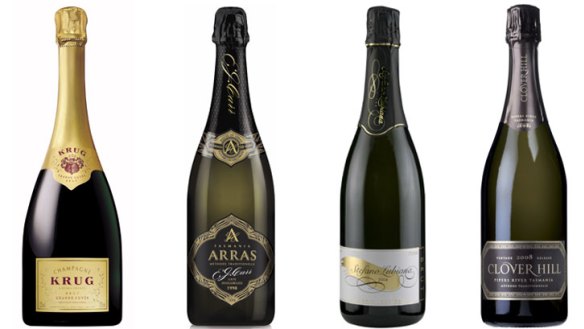Local bubbles no match for French masters
Australian sparkling wines are improving fast, but are still some way off the French masters.

Champagne, from the region of that name in northern France, provides the model for Australia's rapidly maturing premium sparkling wines. We first emulated Champagne-making techniques in the 19th century. But not until the last quarter of the 20th century did we get to the heart of the matter - seeking the right grapes grown in suitably cool regions.
In the first wave, starting in the late '70s, leading winemakers moved away from second-string varieties like ondenc and chenin blanc towards two of the three classic varieties, chardonnay and pinot noir. But resources were small and generally from warmer areas with grapes more suited to table wine than sparkling wine.
The second wave saw grapes planted specifically for sparkling wine. These plantings, in the far south or at high altitude, produced the far better bubblies of the 1980s and '90s. Wines like Croser, Seppelt Salinger, Chandon, Deutz Marlborough Cuvee, Jansz vintage, Hanging Rock, the Hardy range, notably its flagship, House of Arras, made by Ed Carr, and Clover Hill are products of a continuing southward and upward vineyard expansion. (A third wave of evolution may well see most of our best bubblies coming mainly from Tasmania - already the primary source of House of Arras - and New Zealand's South Island.)
What we've witnessed in Australasia is the reverse of what happened in Champagne. There, a marginal climate forced the evolution of sparkling wine; here our search for flavour and delicacy in sparkling wines led inexorably to cooler areas.
Champagne's major city, Reims, lies at latitude 49 degrees 18 minutes north. That's marginal grape-growing territory indeed. Nevertheless, it's the centre of an industry making more than 300 million bottles of sparkling a year.
But for most of its winemaking history Champagne made still wines. The harsh climate, however, ensured great inconsistency of quality from year to year. These tended to be pale and insipid in off vintages. With too little heat and sunshine, grapes tended to be high in acid and low in colour and sugar.
As well, cold autumn days often knocked out the yeast cells before fermentation ended. With spring and warm weather, yeasts sprung back to life converting the remaining sugar in wine barrels to alcohol and carbon dioxide. This natural tendency for wines to effervesce in spring was nature's accident just waiting for people to harness. And when they did, champagne was born (in England, using still wine shipped from Champagne).
Gaining control of the process took centuries. It was perfected only after Pasteur unlocked the mysterious relationship between yeast and sugar, and bottle manufacturers made glass strong enough to resist five atmospheres of pressure.
Rendering champagne sparkling rid the region of its insipid red wines, too.
Red varieties comprise two thirds of the grapes making clear Champagne. Had the evolution from still to sparkling wine meant nothing more than changing from one insipid wine to another, there may have been no vines left in the district today. Instead, the Champagne method unlocked exquisite flavours inherent in these cold-grown grapes.
Grapes struggle to mature at Champagne's latitude. But they achieve ripe flavours at low sugar levels and high acidity. These convert to intensely flavoured, low-alcohol wines of searing acidity requiring skilful blending and years of maturation.
Australia's 1970s bubbly pioneers worked with different raw material. Seaview's Norm Walker, for example, used pinot noir and chardonnay from comparatively warm Coonawarra and Padthaway. But harvesting grapes at comparable sugar levels to those of Champagne produced thin, green wines as the grapes were unripe. And where makers allowed grapes to ripen more, they tended to produce fat and flabby sparkling wines without the intensity or delicacy of Champagne. Thus the search headed upwards and south to cooler growing regions.
Today, the evolution is well advanced. Mid-priced bubblies such as Hardys Sir James and Jacobs Creek Reserve Brut offer phenomenal value and contain high proportions of cool-grown material. And our top-shelf wines such as House of Arras, Stefano Lubiana and Clover Hill offer serious alternatives to some French originals.
But even the best of our bubblies, in my opinion, can't yet match the delicacy, finesse and intensity of the best champagnes, sourced from the finest vineyards. That we don't yet have a Dom Perignon, Krug vintage, Egly Ouriet Blanc de Noirs Grand Cru or Veuve Clicquot La Grande Dame, though, seems hardly surprising.
The French had many centuries to develop sparkling champagne and another two to perfect the winemaking art. Science, plus the French experience, allowed our vignerons to fast-track much of their expertise. But even with the best science, finding the most suitable vineyard sites remains largely a matter of trial and error within defined climatic parameters. All else being equal, this remains the key to quality and future improvement.
But just as we begin to close the quality gap on the French, they're opening a new front. Dozens of so-called ''artisan'' producers (such as Egly Ouriet) now offer single-vineyard or sub-regional champagnes as alternatives to the large-volume blends of the big houses.